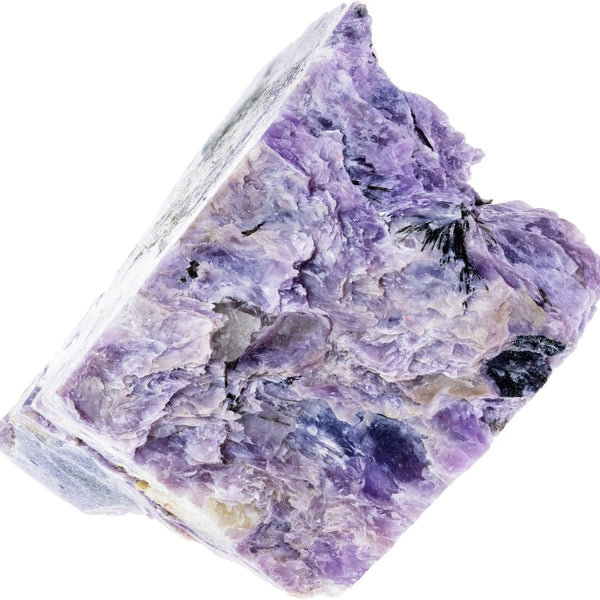
Charoite Gemstone meaning and Spiritual properties
You're not alone if this is your first time hearing about the charoite gemstone. While charoite gemstones are incredibly beautiful, they’re fairly rare. As a result, even some gem enthusiasts aren’t aware of them.
However, once you see your first piece of charoite, it’s a stone you’ll never forget. Calling its colour and patterning breathtaking seems an understatement, and its unique look helps it stand out from other gems.
Here’s what you need to know if you’re curious about charoite – including its composition, colouring, uses, and charoite metaphysical properties.
Charoite Properties

Technically, charoite isn’t a gem. Instead, it’s classified as a silicate mineral, to be precise, and is almost purely composed of the charoite mineral.
One interesting point about charoite is that its makeup is highly complex, so much so that experts can debate its actual chemical composition. The main challenge is finding large, well-formed specimens for analysis. Another is that charoite tends to be interwoven with other minerals when it forms, making it hard to separate the mineral charoite from the other stones.
Charoite tends to be only somewhat transparent. However, it easily accepts a polish, allowing it to have a lovely lustre that’s slightly pearly or silky. When polished, charoite's silky, fibrous structure results in a shimmery, chatoyant or iridescent appearance. There can even be a cat’s eye effect caused by various inclusions typically found in charoite, an optical phenomenon known as chatoyance. The very white flashes in charoite are sometimes caused by tiny white feldspar, contributing to its chatoyant or iridescent appearance.
It’s also important to note that fake Charoite is incredibly prevalent. For example, a version of fluorite is often marketed as charoite, even though it isn’t the real deal. Sometimes, other stones are dyed to match charoite’s look, creating another source of fake charoite.
Fakes hit the market mainly because charoite is relatively rare and can command a decent price tag, giving less scrupulous people or companies an incentive to market a less valuable stone as charoite.
Charoite Stone Color

The charoite stone colour is a distinct purple. The exact hue of a piece of charoite crystal can vary. Sometimes, the purple stone is a light lilac; in others, it’s a deep violet or even a dark eggplant, plum, or indigo. Dark green feldspar can also be seen as contrasting spots in the material, adding to the overall color streaks in the stone.
A variety known as spotty beam charoite features a broad color range, including a purple background with spots of black, golden-yellow, and deep green, creating scenic patterns called 'landscape' charoite.
Most pieces of charoite also feature striations. In most cases, the strands appear like a white crystal, though they may also have translucent areas that lean slightly gray. Yellowish brown spots, most likely Tinaksite, can also be found alongside black Aegirine. The silky, fibrous structure of charoite results in a shimmery-looking polished stone, sometimes showing very white flashes caused by tiny white feldspar.
The History of Charoite

One point of debate with Charoite is the origin of the stone’s name. Some believe it was named after the Chara River in Russia, as charoite deposits are found nearby. Others think the name is derived from the Russian word “chary,” which means “magic” or “charm,” a reference to the impression it leaves on people who see the polished stone for the first time.
Charoite’s history focuses largely on its use as an ornamental stone. The stone’s standout colouring and ability to be beautifully polished made it popular for jewelry, stone inlays, veneers, and similar aesthetic purposes.
With its distinct appearance, charoite jade is also recognized as a natural birthstone for certain zodiac signs and as a planetary stone for Venus.
It’s a favourite with lapidaries looking for a top gem material, unique colour and striking pattern for a creation. While high-quality pieces usually become charoite jewelry, some are turned into small sculptures or items, like spheres or vases.
Additionally, charoite is fairly rare. As a result, using it for industrial reasons isn’t plausible, even if it had properties that would make that possible.
Where Is Charoite Formation Found?
Charoite is usually formed in metasomatic rocks. It occurs through a process called contact metamorphism, where unique chemicals or chemical properties in the limestone and other rocks near the Chara River in Siberia, Russia, contribute to its rarity. Generally speaking, large quantities of charoite are only found in Eastern Russia.
The highly limited number of sources means that charoite isn’t just rare to find but also rare in the market. Russia controls how much is mined and how much makes its way out of the country. As a result, charoite can be more costly than many other stones.
Charoite Gemstones Jewelry

While charoite gemstones aren’t as well known as many other gemstones, jewelry options are still relatively plentiful. You won’t generally find charoite in chain jewelry stores. However, the colour is so incredibly striking that it’s ideal for ornamental purposes, causing many independent designers to enjoy working with the gem. Additionally, the stone is tough enough to stand up to wear, making it a solid choice for a variety of jewelry pieces.
For charoite jewelry, you typically won’t find faceted stones. Instead, the charoite cabochon is much more popular. A cabochon is sometimes favoured for charoite rings, charoite pendants, and even charoite earrings.

You can also find charoite beads, both fully rounded or as tumbled stones drilled for stringing. For example, charoite bracelets usually include beads over another form of the gemstone.
At times, you may come across charoite jewelry pieces featuring raw charoite. However, this is far less common than polished stone versions, as polishing charoite helps the charoite crystal’s colour shine.
CHAROITE MEANING& Healing Properties

Like most stones, the charoite’s meaning varies depending on a person’s belief system.
Charoite rock is a unique and rare violet rock found in Siberia, Russia. It is distinct from the charoite mineral and is known for its healing properties, symbolism, and varying prices.
For some, the charoite meaning focuses on specific chakras. Due to its colouring, it is most strongly associated with the crown chakra. However, some see a relationship between it to the heart or third eye chakra.
Regarding the metaphysical properties of charoite, some believe it serves as a stone of transformation and spiritual growth. It is said to help one access their inner wisdom, deep insight and intuition and connect with higher consciousness states. Charoite is also believed to allow one to develop psychic abilities and spiritual gifts.
Charoite is believed to help with emotional healing, particularly in the areas of fear, anxiety, and stress. It is said to help one release negative emotions and patterns and promote peace and calm.

Some believe Charoite has protective properties, particularly against negative energy and psychic attacks. It is said to help one maintain a strong, energetic boundary and shield against harmful influences.
Charoite is believed to enhance creativity and inspiration. It is said to help one access their imagination and to promote innovative thinking.
While some believe Charoite to have physical healing properties, particularly for the nervous system, liver, and pancreas and to help with detoxification and the elimination of toxins from the body, there is no proof that any stone can prevent, treat, or cure any health condition. If you have a medical issue, seeking care from a trained medical professional is necessary. However, if wearing, holding, or meditating on a stone improves your mood, there’s usually no harm.
Stones similar to charoite
Overall, charoite is so unique that there aren’t many stones with a strong resemblance to it. At times, pieces of purple jade may be of a similar hue, though it tends to lack the distinct patterning. The same can go for purple jasper.
Beam charoite can be found in two distinct appearances: one with a uniformly colored lilac hue and a compact beam and columnar structure, and another with a wide range of colors, including spots of black, golden-yellow, and deep green, creating scenic patterns known as 'landscape' charoite.

Sugilite is a purple-pink gemstone often used in spiritual and metaphysical practices. It is similar in colour to charoite and is believed to have similar healing properties, particularly for emotional healing and spiritual growth.
Lepidolite, or lilac stone, is a purple-pink gemstone often used for emotional healing and stress relief. It has a similar colour to charoite and is believed to help with emotional balance and spiritual growth.

Sometimes, a piece of purple agate or fluorite may also look like charoite. However, the hue may not seem like a great match, and, again, the striations don’t mimic charoite precisely.
Ultimately, charoite’s uniqueness means there aren’t many strong candidates for stand-in stones. However, the options above may work if you want to find something with a similar purple colour.
Frequently Asked Questions About Charoite Stones
Why is Charoite So Expensive?
Charoite's price is influenced by its rarity and unique beauty. It's a relatively rare gemstone found only in one location in the world, which adds to its value. The distinct, vibrant purple colour with swirling patterns of charoite is highly sought after in the gemstone market. The stone's quality, including its colour intensity and pattern, also significantly determines its price.
Is Charoite a Rare Stone?
Yes, charoite is considered a rare stone. It is found exclusively in the Sakha Republic, Siberia, Russia, near the Chara River – where it gets its name. Its limited availability and unique and striking appearance make it a rare and special gemstone.
Can You Sleep with Charoite?
Many people believe in the metaphysical properties of crystals and gemstones. Charoite is a remarkable stone often associated with calming and soothing energies, making it a popular choice for those seeking to enhance sleep quality. It's believed to help overcome insomnia and achieve deep, peaceful sleep. However, these beliefs are based on crystal healing practices, not scientific evidence.
What Crystals Pair Well with Charoite?
Charoite can be paired with various crystals for different purposes. Amethyst enhances its calming effects. Black or smoky quartz can ground it. If you want to amplify its spiritual properties, pairing it with selenite or clear quartz can be beneficial. The choice of pairing depends on the intended purpose and personal preference.
Is Charoite Toxic?
Charoite is not toxic and is safe to handle and wear as jewelry. However, as with any gemstone, washing your hands after handling raw or unpolished stones is advisable. If charoite is to be cut or shaped, proper safety measures should be taken to avoid inhaling any dust, which can be harmful to the respiratory system.
Where is Charoite Found?
Charoite is exclusively found near the Chara River in the Sakha Republic, Siberia, Russia. This specific and singular location contributes to its rarity and value. The conditions in this region led to the formation of charoite's unique colour and patterns, making it a one-of-a-kind gemstone in the world of minerals.

